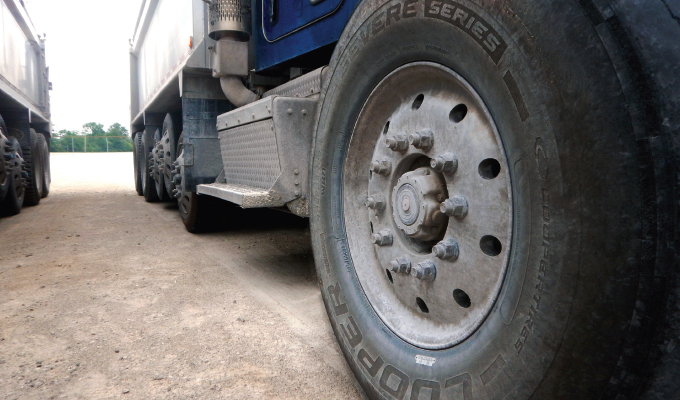There is a lot of technology built into today’s commercial tires. Never have they been tougher, nor have they lasted as long. But all that can go for naught if you don’t choose your tires correctly, or constantly monitor your tire’s condition.
COMPOUNDING
For those running construction trucks in on/off road conditions, it’s critical to think about quality when it comes to your tire purchase. Compounding, tread design, and “stone protectors” all can help make a tire in a construction application last longer. Arguably, compounding is one of the most important aspects. When compounding is not specifically designed for on/off road conditions, it can greatly impact the tire’s performance.
RETREADABILITY
When considering the longevity of a tire, drivers should also be aware of stones that can drill into the tread and penetrate the casing. When that happens, rust can get to the belts and inevitably impact retreadability. To help combat this, look for tires that feature stone protector technology that is built into the tread.
MISALIGNMENT
Unlike for those running over-the-road trucks, construction trucks often experience misalignment issues caused by hitting rocks, chuck holes, and curbs. If your alignment is out, you’ll often notice wear on the outside or inside shoulders of the tires. What’s more, due to constant rough rides, components, such as bearings, bushings, and tie-rods can fail, which can throw irregular wear into the mix.
INFLATION
Monitoring inflation pressure for all tire positions is very important. The proper target inflation pressure should be set according to the maximum load the truck sees on each axle position. However, due to the application of many construction fleets the truck is often fully loaded going out and empty coming back. When the truck is running empty this can take some of the load off the shoulders of the tire, which can lead to faster shoulder wear. This is true in all wheel positions but can be exacerbated with the wide-base tires many fleets run in the steer position.
IRREGULAR WEAR
There are some remedies though. Once you see the irregular wear starting, check out the mechanical condition of your truck, starting with the alignment. Then inspect the vital components that impact how your steer tires track if your alignment is solid.
To stem irregular wear from getting worse on your steer tires, demount your steer tire and flip it around on the wheel. This may help counter the irregular wear and smooth out wear going forward.
HEAL-TOE WEAR
Typically, on drive tires, for on/off road applications, heal-toe wear is a condition to watch for. Most fleets will run open shoulder tires with between four and five ribs in this application. This provides the traction needed off road. However, if you don’t stay on top of inflation levels of your duals—keeping them at the same pressure—or if you run mismatched duals (diameter) then your lugs have more “snap” on the back edge of the lug. As you accelerate, the leading edge of the lug passes smoothly through the road contact patch, but the trailing edge “snaps” back in order to catch up. This also tends to happen more frequently when a truck is used in hilly terrain or high torque applications. The result is a saw-tooth type pattern in your lugs. It’s pretty easy to see, but it’s often easier to “feel” the problem setting in. If you run your hand over the tread, you will spot the problem before you actually see the issue with your eyes. This gives you the opportunity to correct the problem before it gets worse. Get those inflation levels in order and double check your tire circumference especially if you run retreads.
If the heal-toe wear is well underway, it may be difficult to fully undo the problem, but you may be able to keep it from getting worse and salvage some added miles before taking the tire for retreading. A tire rotation, moving the duals to the other side of the truck, will change the direction the tires travel and may help even out the wear on the lugs.
Assuming you have proper maintenance practices in place, and your tires don’t need to be pulled prematurely due to irregular wear, the next question is when should you pull your tires for retreading? This really depends on which tire you are running and the quality of the casing that supports the tread. Talk to your retreader about the rejection rate of the tire you’re currently running to better understand when tires can be pulled.
CLOSING THOUGHT
In the construction industry, tires are a major expense. Look for tires that can give you long miles to removal, have technology, and compounding specific for your application, have stone protectors built into the tread and have quality casings that can handle multiple retreads. If you do, that can give you low cost of ownership (LCO). Couple that with consistent maintenance practices and inspections (from your drivers and shop techs) that can spot problems before they become issues, and you’ll be on your way to running a high-level tire program.
About the Author:
Phil Mosier is the manager of commercial tire development at Cooper Tire & Rubber Company. A 20-year tire professional, he is responsible for the design and development of commercial truck and bus tires for the North and South America regions. Phil and his team have brought to market many successful commercial truck tires in the Cooper Commercial Series and Roadmaster brand tire lines. For more, visit coopertrucktires.com.
Modern Contractor Solutions, March 2022
Did you enjoy this article?
Subscribe to the FREE Digital Edition of Modern Contractor Solutions magazine.



